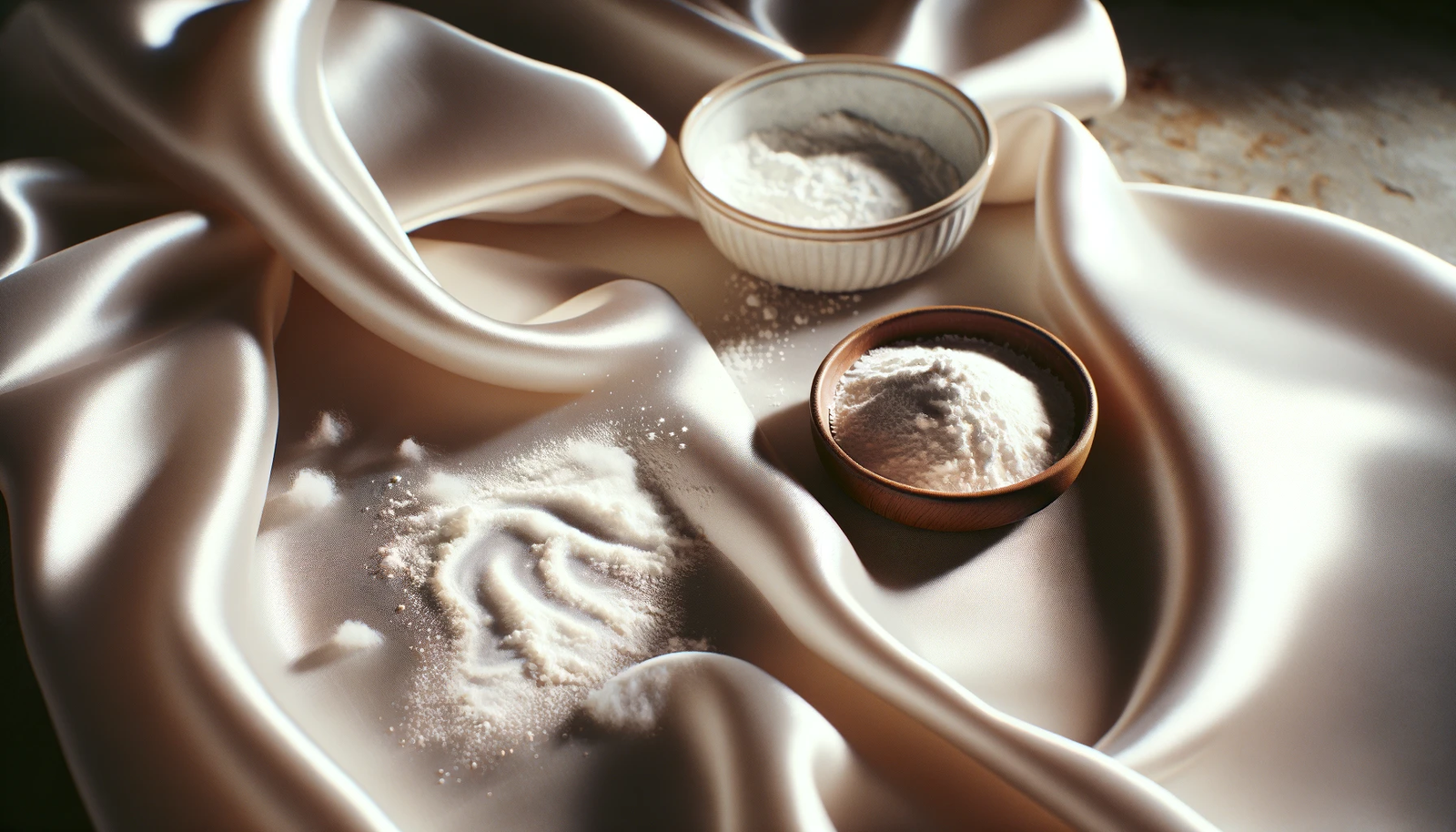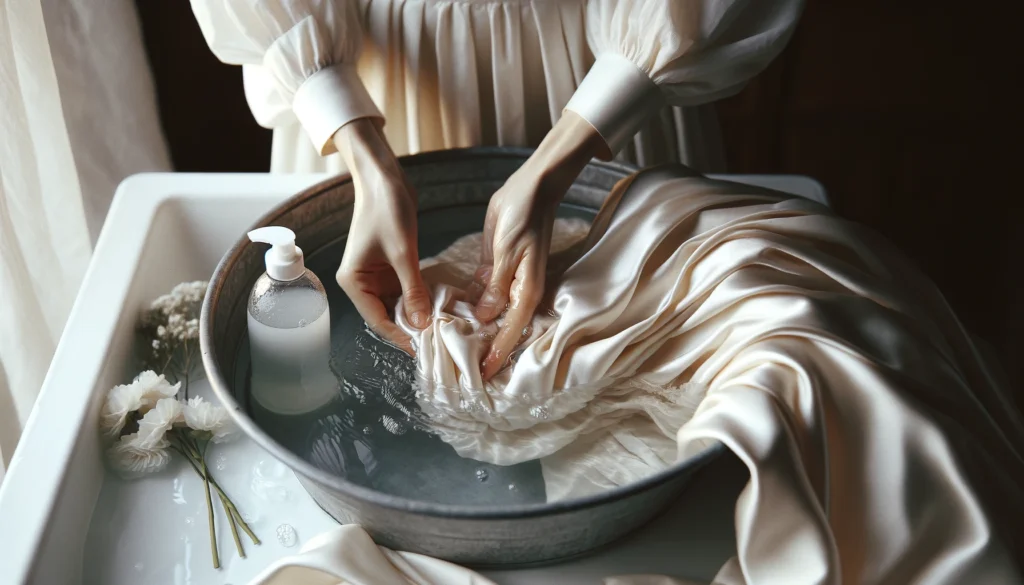Satin is a special kind of fabric. It looks shiny and feels smooth. Many people love wearing satin clothes because they look elegant. But taking care of satin can be tricky.
You must be aware of how to wash satin fabric the right way because if you wash it wrong, it can get ruined. In this article, I will show you the best way to clean satin.
We will make sure you can keep your satin garments looking as good as new.
So, let’s dive in and find out how to take care of this delicate fabric.
Table of Contents
TogglePre-Treatment of Stains on Satin
When dealing with stains on satin, it’s crucial to act quickly but gently. Here’s how to address common stains like grease, oil, and makeup, and some recommendations for natural and gentle stain removers.
For Grease and Oil Stains:
Blot the Stain: Use a clean, dry cloth to blot the stain gently. Avoid rubbing, as this can spread the stain.
Apply Cornstarch: Sprinkle a small amount of cornstarch on the stain and let it sit for a few hours. Cornstarch helps absorb the oil.
Brush Off: Gently brush off the cornstarch. If the stain persists, move to the next step.
Dish Soap: Apply a tiny drop of dish soap to the stain. Dish soap is effective against grease and oil.
Hand Wash: Rinse the area with cold water. If the care label allows, gently hand wash the stained area.
For Makeup Stains:
Gentle Dabbing: Use a slightly damp cloth to dab gently at the makeup stain.
Mild Detergent: Mix a small amount of mild detergent with cool water.
Treat the Stain: Dip a clean cloth into the detergent solution and gently apply it to the stain.
Rinse: After treating, rinse the area with cool water.
Natural and Gentle Stain Removers:
White Vinegar and Water: Mix equal parts of white vinegar and water. This solution is effective for various stains and is gentle on satin.
Baking Soda: For fresh stains, a paste made from baking soda and water can help lift the stain. Apply the paste, let it sit, then gently rinse.
Lemon Juice: Lemon juice is a natural bleaching agent that can help remove light stains. Apply it to the stain, let it sit for a short period, then rinse with cool water.
NOTE :
Always test any stain removal solution on a small, inconspicuous area of the fabric first.
Never use hot water on stains, as it can set them permanently.
For stubborn stains, consider taking the satin item to a professional dry cleaner.
By following these steps and using gentle, natural solutions, you can effectively treat stains on satin fabrics without causing damage.
You Might Also Like: Satin vs Velvet Fabric: A Detailed Comparison for Smart Textile Choices!
Remember, the key is to treat stains as soon as possible and always follow the care instructions on the garment’s label.

How To Wash Satin Fabric Using a Washing Machine?
Here’s a step-by-step guide on how to wash satin fabric using a washing machine:
Step 1: Check the Care Label
Always start by reading the care label on your satin item. This label has crucial information on whether the satin fabric can be machine-washed.
Step 2: Turn the Satin Garment Inside Out
Turning your satin garments inside out protects the outer surface from getting damaged during the wash. This step helps maintain the fabric’s smooth feel and elegant appearance.
Step 3: Use a Mesh Laundry Bag
Place your satin fabric inside a mesh laundry bag before putting it in the washing machine. The bag acts as a protective barrier, reducing friction and preventing snagging with other fabrics.
Step 4: Select a Mild Detergent
Choose a mild detergent that’s gentle on delicate fabrics. Harsh chemicals can damage satin, so it’s important to use a detergent designed for gentle washing.
Step 5: Set Your Washing Machine
Adjust your washing machine settings to the delicate cycle. Ensure the water temperature is set to cold water. Hot water can shrink or warp satin fabrics.
Step 6: Start the Washing Process
Begin the wash cycle, making sure the machine is on a low spin to minimize stress on the fabric. The delicate cycle and cold water helps preserve the fabric’s integrity.
Step 7: Remove Promptly After Washing
As soon as the wash cycle finishes, promptly remove your satin items from the machine. This prevents creases and ensures the fabric doesn’t sit damp for too long, which could lead to damage.
Step 8: Dry the Satin Fabric Properly
Lay the satin fabric flat on a clean, dry towel. Roll the towel and fabric together gently to remove excess water. Avoid wringing the fabric, as this can cause wrinkles and damage.
Step 9: Air Dry Away from Direct Sunlight
Place the satin fabric on an indoor drying rack to air dry. Ensure it’s away from direct sunlight and excessive heat, as these can fade and weaken the fabric.
By following these detailed steps, you can safely machine wash your satin garments, maintaining their elegant fabric and ensuring they last longer.
Remember, proper care is key to preserving the beauty and lifespan of satin items.

How To Hand Wash The Satin Dress
Hand washing a satin dress is the best way to keep it looking its best. Here’s a detailed guide to do it right:
Step 1: Fill a Wash Basin with Cold Water
Start by filling a basin with cold water. Hot water can harm the satin, so stick to cool or cold water.
Step 2: Add a Mild Detergent
Pour a small amount of mild detergent into the water. Look for a detergent that’s safe for delicate fabrics.
Step 3: Submerge the Dress
Gently place your satin dress in the water. Make sure it’s fully submerged and the water covers it completely.
Step 4: Gently Agitate the Water
With your hands, lightly move the water around. This helps the detergent mix well with the water and clean the dress.
Step 5: Let It Soak
Leave the dress to soak in the detergent solution for about 5 minutes. Don’t soak it for too long to avoid damage.
Step 6: Rinse with Cold Water
After soaking, remove the dress from the detergent solution. Rinse it under cold running water to wash away all the detergent.
Step 7: Remove Excess Water
To get rid of excess water, gently squeeze the dress. Avoid wringing it out, as this can damage the fabric.
Step 8: Use a Dry Towel
Lay out a clean, dry towel and place the wet dress on it. Roll the towel and dress together to absorb more water.
Step 9: Air Dry the Dress
Finally, hang the dress on a hanger and let it air dry. Avoid direct sunlight, and don’t use a dryer.
Hand washing your satin dress carefully can keep it in great condition. Remember, satin is a delicate fabric that needs gentle care.

Drying and Ironing Satin Fabric
Drying and ironing satin fabric requires careful attention to avoid damage and maintain its luxurious texture. Here are the best practices for drying satin and guidelines for ironing this delicate fabric.
Drying Satin Fabric
Avoid Wringing Out Water:
Never wring out satin garments to remove excess water. This can distort the shape and damage the fabric.
Use a Clean Towel:
Lay a clean, dry towel flat on a surface and place the satin item on top of it.
Roll the Fabric in the Towel:
Gently roll the towel with the satin inside to absorb the water. Press lightly to avoid squeezing the fabric too hard.
Air Dry:
Unroll the towel and remove the satin garment. Lay it flat on a drying rack away from direct sunlight and heat.
Reshape the Fabric:
If necessary, reshape the fabric gently by hand when it’s still slightly damp.
Ironing Satin Fabric
Check the Label:
Always read the care label for ironing instructions specific to your satin garment.
Iron While Damp:
If the fabric is slightly damp, it’s easier to remove wrinkles. If it’s dry, use a fine mist spray bottle to lightly dampen it.
Use a Pressing Cloth:
Place a thin cloth, like a handkerchief or a pressing cloth, between the iron and the satin fabric to protect it.
Set the Iron to Low Heat:
Use the lowest heat setting on your iron. High temperatures can scorch or melt satin.
Iron Inside Out:
Turn the garment inside out to prevent the iron from directly touching the shiny surface.
Gentle Movements:
Gently glide the iron over the fabric without pressing down too hard. Move the iron continuously to avoid overheating any area.
By following these steps, you can ensure that your satin fabric dries without damage and that ironing enhances its smooth feel without risking scorch marks.
You Might Also Find it Useful: Chiffon vs Satin: Discover the Ultimate Winner in Elegance (2024)
Remember, satin is a delicate fabric that requires a gentle touch to maintain its elegant appearance.

Common Mistakes to Avoid
When washing satin, some common mistakes can harm the fabric’s appearance and feel. Here’s what to avoid and how these mistakes can affect your satin items.
Using Hot Water:
Hot water can cause satin to shrink or lose its shape. Always use cold water to keep the fabric in good condition.
Wringing the Fabric:
Wringing satin can lead to wrinkles and damage the delicate fibers. Instead, gently squeeze out excess water or roll the item in a dry towel.
Overloading the Washing Machine:
Putting too many items in the washing machine with your satin can cause friction and pull on the fabric. This can lead to snags and tears.
Using Harsh Detergents:
Strong detergents can strip away the fabric’s sheen and weaken the fibers. Use a mild detergent designed for delicate fabrics.
Drying in Direct Sunlight or High Heat:
Direct sunlight and high heat from a dryer can fade and weaken the satin fabric. Air dry satin items away from direct sunlight and avoid using the dryer.
Ironing on High Heat:
High heat can scorch satin, leaving permanent marks. Always iron satin on the lowest heat setting and use a pressing cloth.
Ignoring the Care Label:
The care label provides specific instructions for washing and caring for satin. Ignoring these instructions can lead to damage.
Effects on the Fabric:
Appearance: Mistakes like using hot water, wringing, or ironing on high heat can cause the satin to lose its smooth feel and elegant sheen. Stains may become set, and colors can fade.
Feel: Harsh detergents and improper drying can make satin feel stiff and less comfortable against the skin.
Durability: Over time, these mistakes can weaken satin fibers, making the fabric more prone to tears and reducing its lifespan.
By avoiding these common mistakes, you can maintain the luxurious appearance and feel of your satin garments, ensuring they last longer and continue to look their best.

Special Considerations for Satin Fabric Care
Caring for satin fabric requires attention to detail to prevent damage during washing and to ensure garments remain wrinkle-free and maintain their integrity. Here are some tips and advice for handling satin items.
Tips for Preventing Damage During Washing
Use a Mesh Laundry Bag: Always place satin garments in a mesh laundry bag before putting them in the washing machine. This protects the delicate fabric from snagging or tangling with other items.
Select the Right Detergent: Opt for a mild detergent that’s gentle on delicate fabrics. Harsh chemicals can damage the elegant satin fabric.
Choose the Correct Wash Cycle: Set your washing machine to a delicate cycle with cold water. This helps prevent shrinkage and protects the fabric’s texture.
Avoid Overloading: Don’t overload the washing machine. Satin needs space to move freely in the water to prevent stress on the fabric.
Advice on Storing Satin Garments
Avoid Folding: If possible, hang satin garments rather than folding them. Folding can create creases that are difficult to remove.
Use Padded Hangers: When hanging satin items, use padded hangers to avoid marks or creases on the shoulders of the garments.
Keep Away from Direct Sunlight: Store satin in a cool, dark place. Direct sunlight can fade the colors and weaken the fabric over time.
Use Garment Bags: For extra protection, store satin garments in garment bags. This keeps them dust-free and helps maintain their condition.
By following these special considerations for satin fabric care, you can ensure your satin garments stay beautiful and last longer.

Frequently Asked Questions (FAQs)
What are Some Other Types Of Fabric That Should Be Stored In A Mesh Laundry Bag
Lace, chiffon, and other delicate fabrics benefit from a mesh laundry bag to prevent damage.
What are Some Common Causes Of Wrinkles In Satin Fabric
Wrinkles in satin fabric often result from improper washing, drying, or storing methods.
What are Some Tips For Storing Satin Garments In A Small Closet
Use padded hangers, avoid overcrowding, and fold items with acid-free tissue to prevent creases.
Wrapping it Up
Taking care of satin can be simple if you know the right steps. We’ve walked through how to wash satin fabric, from treating stains to drying and ironing.
Remember, whether you’re dealing with a satin dress or a delicate blouse, gentle care is key. Use these tips to keep your satin looking smooth and luxurious.
With proper washing, drying, and storing, your satin garments will stay beautiful for years to come.
Keep these methods in mind next time you clean your satin, and enjoy the elegant look of your well-cared-for fabric.


